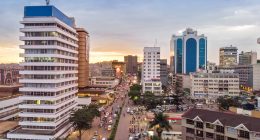While on a recent visit to the United Nations Economic Commission for Africa in Ethiopia, in May 2018, I travelled from Uganda using Ethiopian Airways. It was interesting to learn that the airline that flies to over 100 destinations globally has 4 flights from Entebbe airport daily and a fifth is expected soon. This is one of the highest frequencies of any airline operating out of Entebbe. However, the high frequency of flights is not reflected in Uganda and Ethiopia’s economic ties like trade and investment. Another vivid observation is the number of Ethiopians (from pilots to air hostesses) in service on the airline – which was a pointer to local content promotion.
As Uganda thinks of its own airline, there may be lessons to learn from not only Ethiopia, but also Kenya, South Africa and Rwanda. One such lesson: in all these cases, the fiscal burden of running each airline on the respective governments is immense.
As I took in the sights and sounds of Addis, at the back of my mind was the illustrious economic growth Ethiopia has enjoyed over the last decade. The country at 8.3% registered the fastest GDP growth in Africa in 2017 and is poised to continue on this trajectory. As you would expect, growth in Ethiopia is mostly urban-centred, and the level of infrastructure boom in Addis Ababa is notable. Like Ethiopia during its first Growth and Transformation Plan (GTP I), Uganda has also had its own fair share of investment in infrastructure (two thirds of public and private investment are in brick and mortar) over the first National Development Plan (NDP I) from 2010 to 2015. However, that is where similarities end.

Over the same period (2010-2015) Ethiopia registered double digit economic growth which is more than twice Uganda’s. This growth led to Ethiopia’s GDP per capita more than doubling from its 2010 figure. The same trend had taken Uganda nearly two decades to attain. Moreover, with a population growth rate of 2.5% per annum (roughly comparable to Uganda’s at 3%) and nearly three times Uganda’s population, Ethiopia’s fate is quite unimaginable.
It is against this backdrop that the rest of the article tries to interrogate the factors that have underpinned this growth success story over the last 15 years despite Ethiopia’s policy experimentation going against the Bretton Wood Institutions (the World Bank and IMF) Policy Framework sometimes.
Going Against Convention
Strange enough, Ethiopia’s high growth epochs coincide with high levels of inflation which is contrary to the theoretical scissor relationship between the two. Additionally, the government still retains control over the exchange rate regime. All foreign currency transactions must be approved by Ethiopia’s central bank, the National Bank of Ethiopia (NBE), and the local currency (Birr) is not freely convertible. It is also over this high-growth period that Ethiopia has had a spate of internal conflicts, especially in the restive Oromia region over plans by the government to acquire land for expansion of Addis Ababa.
Between 2010 and 2015, all the major sectors (agriculture, services and industry including manufacturing) in Ethiopia grew by 10 percent or more per annum. This growth has been largely public sector led with massive investments in agriculture and infrastructure for industrialization through such projects as the over 6,000 MW Grand Ethiopian Renaissance Dam, a railway link to Djibouti, among others.
While Africa as a continent is considered to be de-industrialising; particularly economic giants South Africa and Nigeria, Ethiopia is industrializing. Since 2010, industry sector GDP (value added) has witnessed an annual average growth rate of 20% thanks to the country’s investment in industrial parks with accessible infrastructure, one stop centres and substantial incentives to manufacturers. Such incentives include cheap electricity and railway transport. At 3 US cents per unit, Ethiopia has the cheapest cost of power in Africa for industries; while industrial parks (also involved in agro- processing) like Bole Lemi are linked to the existing modern railway lines like the 120 km-per-hour Addis Ababa-Djibouti line completed in 2016.

A Modest Boom
Despite this rapid economic growth and industry evolution, Ethiopia remains a low-income country. The country hopes to attain lower middle-income status by 2025 and its industry share to GDP is the range of Uganda’s at 22%. However, Uganda has a higher share of manufacturing to GDP, primarily due to fact that Ethiopia was coming from a low base while Uganda’s share has merely increased by only 3 percentage points since 1990. The manufacturing sector in Ethiopia is currently characterized by low-value added products in agriculture processing and consumer goods.
While industrialization is the most efficient path to development, countries that rely on primary products tend to have limited structural transformation. The 2017 UNECA Economic Report for Africa reiterates the significance of industrialization showing that a 1% increase in industry employment leads to a 0.8% reduction in poverty. The report also underscores the need for regional and urbanization policies to factor industrialization in planning and vice versa. As already underscored, Ethiopia offers a model (although not absolute) for Uganda to look at as it aims to develop its 23 industrial parks. In his book Made in Africa, Dr. Arkebe Oqubay (a Minister and Special Adviser to the Prime Minister of Ethiopia) affirms that Industrial policy making in Ethiopia is work in progress, but industrial policy can work and thrive in a low-income African country, and the state can and should play an activist developmental role, with policy independence an important ingredient. In short: when politics and institutions work, economics thrives.







